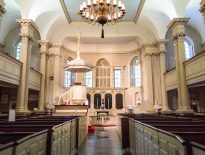What do you think of when you hear the word church? Perhaps your mind conjures up images of ancient cathedrals, resplendent with gothic spires, stained glass windows, and vaulted ceilings.
Maybe you think of the image of the church from centuries ago—people who resemble the stereotypical Amish, kneeling between uncomfortable pews. It’s even possible that you have a more negative image that springs to mind—perhaps the Westboro Baptist Church, whose message seems to be solely focused on spouting hate and division.
No matter which image comes to mind, it’s fair to say that people have many different opinions on the church. In many countries in the West today, the church is an Institution—with a capital “I”. When journalism is referred to as the “fourth estate”, it is building on a theoretical view of the world which positioned the clergy (and by extension the church) as the first.
But while the church as we know it is considered a core pillar of modern society, this was not always the case. To explain what I mean, we must turn to the Bible and the foundation of the church.
How did the church begin?
When all the history and modern traditions are stripped away, the role of the church is surprisingly simple. The word itself comes from the Greek ecclesia which means “an assembly of people.” With this understanding, it is clear when the Bible refers to the church, it is simply referring to a gathering of people who share belief in Jesus Christ. This is highlighted by Christ’s own words, that “where two or three are gathered in my name, there I am among them” (Matthew 18:20).
The church is a community built to support people with common faith beliefs. Throughout the Bible, various authors work to highlight different ways in which this community can support each other. In speaking of the early church, 1 John 4:11, for example, notes the importance of loving one another, while 1 Corinthians 14:26 and Hebrews 10:24-25 highlight the necessity to provide encouragement and support to those who we surround ourselves with.
Members of the church are not perfect, but the Bible clearly outlines that this should not cause division. Instead of attacking or creating conflict over the flaws of members, the church is a place where support can be found. God understands the difficulty present in being solitary (as we can see in the story of the creation of Eve for Adam) and has provided the church as a way of easing the burdens that life brings, whether you are a new believer or a lifelong one.
Who runs the church?
You may have a better idea of what the focus of the church is now, but there are likely questions that remain—including who runs the church. The first image that may come to mind for many is the pope, who is the head of the Catholic Church. Catholicism has a defined hierarchy for the church, with bishops, archbishops, pontifexes and more, all reporting to the pope, who sits at the head—and is believed to be God’s voice to the world.
But the authority of the pope is limited to that of the Catholic church. Many forms of modern-day Christianity broke away from Catholicism in the 16th century due to its perceived straying from the mission presented to believers in the Bible. This event was known as the Reformation and is where many expressions of modern Protestantism originated.
One of the key issues that Reformers like Martin Luther had with the church of the time was the corruption in leadership. Church leaders had exploited the faith of believers to line their own pockets and live a life of decadent excess. As a result, many churches in the present day aim to put the focus back on Christ as the ultimate head of the church and rely on biblical principles to manage the running of it.
The Bible tells us that Jesus established the church, giving His followers—the apostles—leadership authority to help and guide the people. In this way, Jesus provided an outline for how the church should function—with leadership working to benefit all members of the congregation, and not themselves. Many churches today, including the Seventh-day Adventist Church, elect members to leadership positions, with a larger organising body working to provide administrative oversight.
Why are there so many different churches?
One of the things that has confused many is the various labels that Christians may assign themselves. Catholic, Orthodox, Protestant, Baptist, Anglican, Adventist… it’s all a bit confusing.
Thankfully, these labels can be separated into three main groups. Firstly, there is Catholicism, which is often associated with much of the iconography that is thought of as Christian. The pope and his clothes, the stained-glass windows, and large chapels.
Then there’s the Orthodox Church, which split from the Catholic Church in the 11th century. Sometimes called the Eastern Orthodox Church, this church is particularly prominent in Eastern Europe, Russia, the Mediterranean and North Africa, and shares many commonalities with Catholicism, including the veneration of the Virgin Mary—Jesus’s mother.
Finally, there is the Protestant Church. As mentioned earlier, the Protestant movement sprung out of Catholicism in the 16th century with an aim to refocus the core of faith on Jesus and His mission. The Protestant movement has created many smaller denominations of Christian churches, including the Anglicans, Baptists, Adventists and Pentecostals. If it isn’t Orthodox or Catholic, it is likely that a church identifies itself as Protestant.
So, what sets these Protestant churches apart from each other? The simple answer is: it varies.
Different churches interpret different parts of the Bible in ways which lead to new denominations forming. The Adventist Church, who produce Signs of the Times for example, place particular emphasis on passages explaining the importance of maintaining a day of rest—the Sabbath—as God commands, as well as the importance of the second coming of Jesus, which is believed to be a soon-coming event on an undisclosed date.
What’s up with all the strange metaphors?
You may have heard some people using metaphors to describe the church—metaphors which might sound confusing at first. It’s only when these metaphors are explained that they can highlight what makes church so special. Here’s a brief explanation of the top three metaphors used in the Bible.
1. The bride of Christ
This metaphor is often used to represent both the love that Christ has for His followers, and the expectations that might logically follow this love. The church is a bride as it is made up of the people He died to save, so great was His love for them. In a similar way, those in the church are invited to put the wants and desires of Jesus before all others, much like a person does for their spouse.
2. The body of Christ
This metaphor drives home the all-encompassing nature of the love that Christ has for us, and that we should have for Him. The church, like all organisations, has a lot of people in a lot of different roles. This metaphor is one used to highlight how it should function. Ephesians 4:16 states: “From Him the whole body, joined and held together by every supporting ligament, grows and builds itself up in love, as each part does its work.” This verse is the clearest indication of the meaning of this metaphor: different people in the church have different tasks, just like individual body parts, but all of them are ultimately in service of the Head—Jesus Christ.
3. The family of God
Beyond being a body, the church is also often spoken of as a family. This, perhaps unsurprisingly, is a relatively straightforward metaphor, once again highlighting the loving relationships that should occur within the church. Like with any family, we should strive for relationships built on the foundation of love and respect. Disagreements and differences may occur, but the important thing is that we focus on treating everybody in the church (and outside it) as we would those who are closest to us.
Why is the church important?
These metaphors not only highlight how the church should act, but why it is important. A consistent theme running through the Bible is that we live in a broken world. Attempting to follow God and do what is right can be a difficult task.
The Church is God’s response to these challenges. When it is functioning as intended, it is a place for support, for fellowship, for encouragement. It provides an opportunity to better ourselves and others. As Proverbs 27:17 states: “Iron sharpens iron, and one man sharpens another.” This is the function of the church: to strengthen and support one another as we await the return of Jesus. Want to try for yourself?
Ryan Stanton is a PhD student studying media and communications at the University of Sydney, in Australia. A version of this article first appeared on the Signs of the Times Australia website and is republished with permission.



















